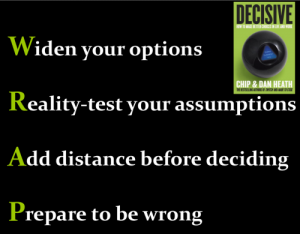By Rose O. Sherman, EdD, RN, FAAN
“Research in psychology has revealed that our decisions are disrupted by an array of biases and irrationalities. We are overconfident. We seek information that supports us and downplay information that doesn’t.” Chip and Dan Heath
 Nurse leaders have numerous decisions that need to made each day. This is tough in any environment but even greater today when there are so many uncertainties about the future of healthcare. Most of us probably feel very confident that based on our education and experience, we can quickly arrive at the best solutions. In their new book, Decisive: How to Make Better Choices in Life and Work, well known leadership authors Chip and Dan Heath suggest that our thinking is often flawed and we fail to consider a range of options. The Heaths argue that humans are hampered by four “enemies” of decision-making rooted in our unconscious behavior: narrow focus, confirmation bias, short-term emotion and overconfidence in the outcome. Too many of us just look at the information in front of us and trust our guts too much in make decisions. The solution to better decision making is to expand your thinking.
Nurse leaders have numerous decisions that need to made each day. This is tough in any environment but even greater today when there are so many uncertainties about the future of healthcare. Most of us probably feel very confident that based on our education and experience, we can quickly arrive at the best solutions. In their new book, Decisive: How to Make Better Choices in Life and Work, well known leadership authors Chip and Dan Heath suggest that our thinking is often flawed and we fail to consider a range of options. The Heaths argue that humans are hampered by four “enemies” of decision-making rooted in our unconscious behavior: narrow focus, confirmation bias, short-term emotion and overconfidence in the outcome. Too many of us just look at the information in front of us and trust our guts too much in make decisions. The solution to better decision making is to expand your thinking.
The 4 Step WRAP Model
Widen Your Options-
In our decision making, we often turn our choices into either/or without expanding our options. The Heaths suggest that you ask yourself the question – If I could not choose either one of these options, what else would I do? – to avoid narrowing your options. I recently had the opportunity to talk with a Chief Nursing Officer who used this technique in a hiring decision. She was stuck because she could not find an experienced perioperative nurse leader to replace a retiring director. She initially felt her only choice was to hire an interim leader at considerable expense to the organization. She then expanded her thinking by asking herself whether having the OR experience was a “must” and could she perhaps find a very competent leader in another specialty area to take on the challenge. She did this and it has been very successful.
Reality Test Your Assumptions
Many of us regularly consult rating sites such as amazon, trip advisor or yelp before we buy a product, use a hotel or visit a restaurant. Unfortunately, we don’t always test our assumptions in the same way in our leadership roles. We need to seek and listen closely to dis-confirming opinions. If you buy this supply or product, will it work as well in your setting – check what others have to say but consider the unique features of your environment. If you hire this staff nurse, can she or he meet the expectations of your organization. Past experience may be a key to future success but not always. Front-line nursing staff can often provide excellent reality checks about decisions for nurse leaders.
Attain Distance before Deciding
I am often asked by my graduate students how to respond to job offers. My first word of advice is always the same – take some time before saying yes. Put some time between you and a decision and you can take the short-term emotion out of it. We can be too easily influenced by what feels familiar to us and our potential loss aversion. If it is a very important decision, ask yourself how you will feel about a potential choice in 10 minutes, in 10 month and in 10 years. Always honor your core priorities.
Prepare to be Wrong
Even when taking the three above steps, not every decision that you make will be the right one. I recently read a quote from Kathleen Sanford, Senior Vice President and Chief Nursing Officer for Catholic Health Initiatives. She said that she regularly tells staff that “what I say today may not be true tomorrow.” While this may not seem reassuring to her staff, it is an honest appraisal of the current healthcare decision making environment. We all do need to prepare to be wrong about some of the decisions being made today.
Having a process to help you in your decision making is important. Pay close attention to dis-confirming information. Look for alternate ways to frame the problem. Be prepared to act if things go unexpectedly well or poorly. The process described by the Heaths in their book doesn’t guarantee a good outcome. But it sets guardrails to keep you from falling into the common decision-making traps.
Heath, C. & Heath, D. (2013). Decisive: How to make better decisions in Life and Work. New York: Crown Books.
[amazon asin=0307956393&template=iframe image&chan=default]
© emergingrnleader.com 2013


 LinkedIn
LinkedIn Instagram
Instagram